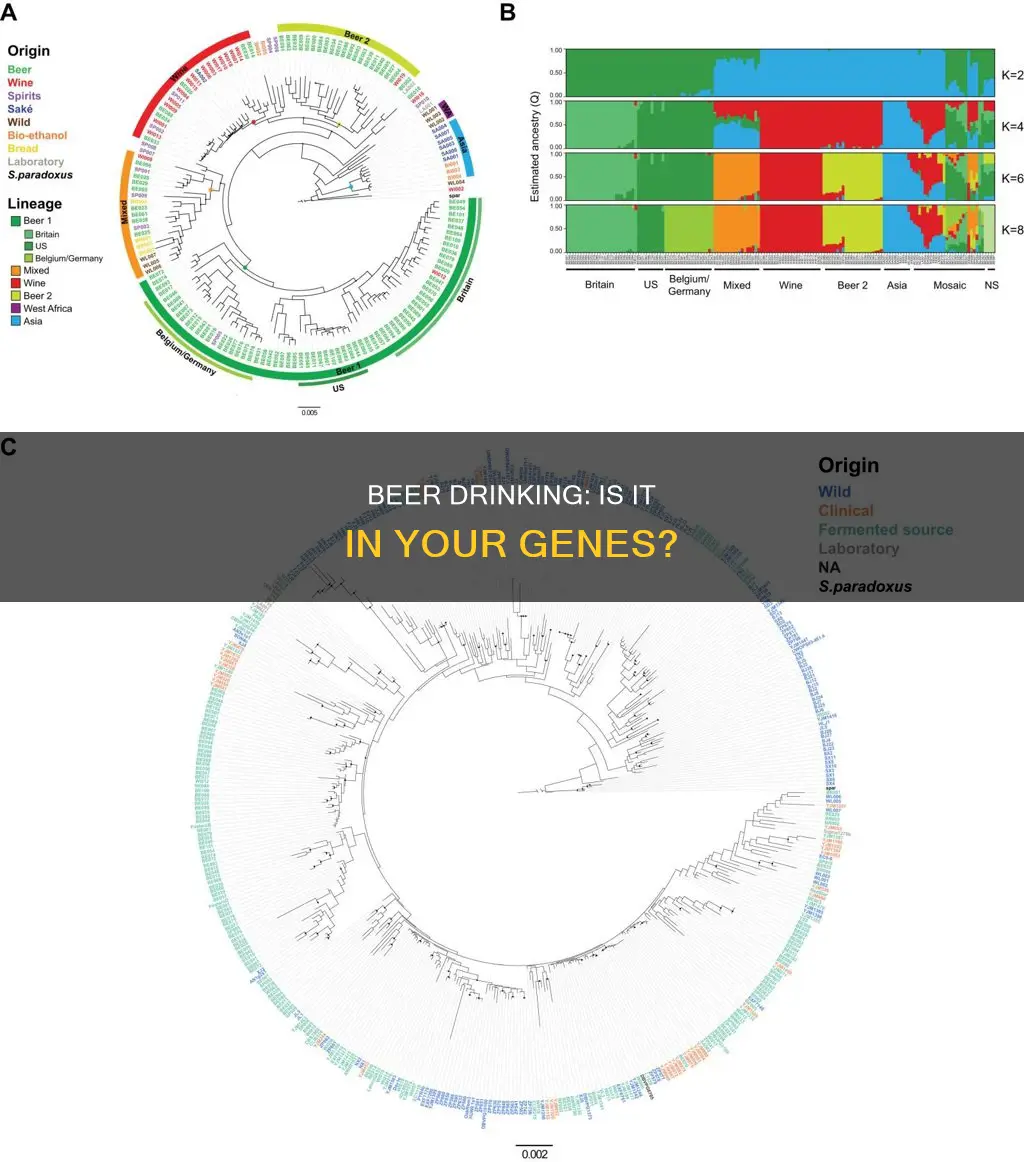
Alcohol is a widely consumed beverage, but excessive use can lead to serious physical, psychological, and social problems. Research suggests that genetics may play a role in an individual's preference for alcoholic beverages.
There are between 20,000 and 25,000 genes in the human genome, with approximately 40 genes responsible for detecting bitter flavors and only 2 for detecting sweetness. The TAS2R38 gene has been identified as the bitterness gene that affects an individual's ability to taste bitter flavors. Additionally, there are believed to be around three genes that affect hop detection.
Genetic variations in the TAS2R13 and RAS2R38 bitter-receptor genes have been linked to alcohol consumption. Individuals with certain variants of these genes rated the taste of alcohol as more intense and drank less often. However, it is important to note that environment and cultural factors also play a significant role in alcohol consumption.
Further research is needed to confirm the relationship between genetic differences in taste perception and drinking habits. While genetics may influence an individual's preference for alcoholic beverages, it is not the sole determinant, as personal choices and cultural factors also come into play.
| Characteristics | Values |
|---|---|
| Number of genes in the human genome | 20,000-25,000 |
| Genes that detect sweetness | 2 |
| Genes that detect bitter flavors | 40 |
| Bitter-taste receptor genes | TAS2R13, TAS2R38, TRPV1 |
| Burn receptor gene | TRPV1 |
| Alcohol dehydrogenase genes | ADH1A, ADH1B, ADH1C, ADH2, ADH4 |
| Aldehyde dehydrogenase genes | ALDH2 |
What You'll Learn
- The gene TAS2R38 affects the ability to taste bitterness, which influences alcohol consumption
- The TAS2R13 gene influences the taste of alcohol
- The TRPV1 gene influences the burn sensation from alcohol
- The TAS2R38 gene is associated with alcohol intake
- The TAS2R14 gene allows us to perceive bitter tastes

The gene TAS2R38 affects the ability to taste bitterness, which influences alcohol consumption
The gene TAS2R38 influences the ability to taste bitterness, which in turn affects alcohol consumption. TAS2R38 is a bitter taste receptor gene located on chromosome 7q36. It has three common polymorphisms – A49P, V262A, and I296V – which combine to form two common haplotypes: AVI (often referred to as "nontaster") and PAV (often referred to as "taster"). The TAS2R38 protein confers sensitivity to the bitter-tasting compounds 6-n-propylthiouracil (PROP) and phenylthiocarbamide (PTC).
People with the PAV/PAV homozygous genotype perceive PROP as more bitter than TAS2R38 heterozygotes, while those with the AVI/AVI homozygous genotype often report PTC as essentially tasteless. This is because the AVI polymorphism may code for a receptor that processes a different and undiscovered bitter compound, or it may have no functional ligand.
Research has shown that people who find PROP to be more bitter also find the taste of ethanol to be less pleasant. Additionally, those with nontaster alleles were found to consume more alcohol over the course of a year. This suggests that increased perception of bitterness could be associated with consumption of some bitter beverages.
Beer Olympics: Competitive Drinking Games Explained
You may want to see also

The TAS2R13 gene influences the taste of alcohol
The TAS2R13 gene is a bitter taste receptor gene. It is one of three chemosensory genes that influence how people perceive and taste alcohol. The other two genes are TAS2R38, another bitter taste receptor gene, and TRPV1, a burn receptor gene.
The TAS2R13 gene has been found to influence alcohol consumption in patients with head and neck cancer. A single nucleotide polymorphism (SNP) in the TAS2R13 gene has been associated with measures of alcohol consumption assessed via the Alcohol Use Disorders Identification Test (AUDIT).
The TAS2R13 gene is also one of many genes that have been found to contribute to the risk of alcoholism.
Beer and Farxiga: What You Need to Know
You may want to see also

The TRPV1 gene influences the burn sensation from alcohol
The TRPV1 gene, also known as the vanilloid receptor-1 (VR1) gene, influences the burn sensation from alcohol. The VR1 receptor is a non-selective gated ion channel that is encoded by the TRPV1 gene. It is usually activated by temperatures greater than 43 degrees Celsius, acidic conditions, and capsaicin. Alcohol activates the VR1 heat receptor in the mouth and throat, causing a burning sensation.
The TRPV1 gene is sensitive to alcohol in a concentration-dependent manner. Ethanol lowers the activation threshold of the VR1 receptor, which means that the body's own heat can cause a burning sensation. Knocking out the TRPV1 receptor in mice has been shown to increase their preference for and consumption of alcohol.
The TRPV1 gene has been linked to the perception of burn and bitterness from alcohol. Studies have found that individuals with certain variants of the TRPV1 gene experience greater burn and bitterness from alcohol, which may deter consumption. However, the relationship between burn sensation and alcohol intake is complex, as personality traits and other factors also play a role.
Miscarriage Recovery: Beer and Alcohol Consumption
You may want to see also

The TAS2R38 gene is associated with alcohol intake
The TAS2R38 gene is a bitter taste receptor that influences the ability to taste 6-n-propylthiouracil (PROP) and phenylthiocarbamide (PTC). The TAS2R38 gene has two common haplotypes: PAV and AVI. The PAV haplotype is often called the "taster" and the AVI haplotype the "nontaster". The PAV/PAV and AVI/AVI genotypes are homozygotes, while the PAV/AVI is a heterozygote.
Research has shown that the level of alcohol consumption may correlate with the level of perceived bitterness of ethanol; people who find PROP to be more bitter also find the taste of ethanol to be less pleasant. However, the TAS2R38 genotype could not predict the intensity of alcohol bitterness. Instead, it was found that the TAS2R38 genotype could predict alcohol intake; those with nontaster alleles were more likely to consume more alcohol over the course of a year. This suggests that there is a link between the TAS2R38 gene and alcohol intake.
Beer and No-Carb Diets: What You Need to Know
You may want to see also

The TAS2R14 gene allows us to perceive bitter tastes
The TAS2R14 gene is a member of the taste receptor family and is involved in the perception of bitter tastes. It is a G-protein-coupled receptor, specifically expressed in the taste receptor cells of the tongue and palate epithelia. The TAS2R14 gene is located on chromosome 12p13.
The TAS2R14 gene has several polymorphic variants, and several bitter substances that activate it are powerful toxic and carcinogenic agents. For example, picrotoxin, an antagonist of GABAA-receptors, and aristolochic acid, a strong carcinogen used as a herbal remedy for weight loss, have been shown to activate TAS2R14.
The TAS2R14 gene has been linked to the detection of harmful drugs and toxins in the gastrointestinal tract, and genetic variants affecting its capability of initiating these responses may be critical for the subsequent efficiency of the gut in eliminating possible threats.
Beer and Lipitor: Safe Mix or Health Risk?
You may want to see also
Frequently asked questions
Drinking beer is influenced by genetics. People may differ in the sensations they experience from a beverage, and these perceptual differences have a biological basis. The TAS2R38 gene has been identified as the bitterness gene that affects whether we can taste bitter flavors or not. There are also believed to be around three genes that affect hop detection.
The more people taste bitterness, the less likely they are to drink alcohol, and vice-versa. People with the bitterness variant of the RAS2R38 gene drank half as often as those without it.
Biology is not destiny. Environment is also hugely important. Some people might find it easier to drink, but they still might not drink more because of religion or culture.







